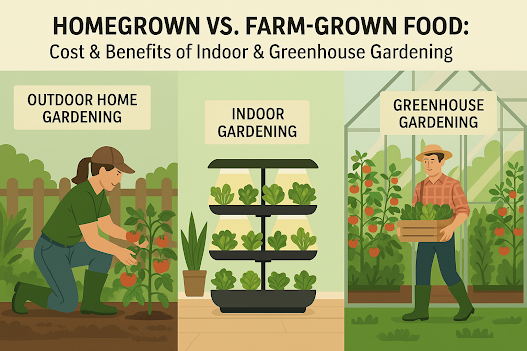Homegrown vs. Farm-Grown: Cost & Benefits of Indoor & Greenhouse Gardening
When considering the most cost-effective way to obtain fresh food, many people debate between homegrown and farm-grown options. However, indoor and greenhouse gardening provide additional solutions for year-round food production, whether for personal or commercial growing. Let’s compare costs, benefits, and long-term sustainability.
 |
| Comparison of outdoor gardening, indoor hydroponics, and greenhouse growing, showcasing sustainable and cost-effective food production methods. |
The Costs of Homegrown Food
Growing food at home can be a cost-effective choice, but expenses depend on the method used. Basic outdoor gardening costs include:
-
Seeds or seedlings – A $5 seed packet can yield pounds of produce.
-
Soil and fertilizers – Composting at home can reduce these costs.
-
Water usage – Rainwater collection helps save on irrigation.
-
Tools and maintenance – Initial investments in gardening tools pay off long-term.
-
Time and labor – Gardening requires ongoing effort but provides fresh, chemical-free food.
Indoor & Greenhouse Gardening Costs
Indoor and greenhouse growing allow for controlled environments, but they involve unique costs:
Indoor Gardening (Hydroponics & Vertical Farming)
-
Lighting – LED grow lights increase electricity costs.
-
Hydroponic systems – Starter kits range from $50 to $500+.
-
Climate control – Fans, humidifiers, and temperature control add expenses.
-
Space limitations – Indoor setups may limit crop variety and yield.
Greenhouse Gardening
-
Initial structure cost – DIY greenhouses start around $300, while commercial options cost thousands.
-
Heating & cooling – Maintaining temperature in extreme weather adds expenses.
-
Water management – Drip irrigation or rainwater harvesting reduces costs.
-
Extended growing seasons – Increases yields and overall savings.
The Costs of Farm-Grown Food
Farm-grown produce is convenient but comes with price variability due to:
-
Production & transport costs – Fuel, labor, and shipping increase prices.
-
Organic vs. conventional – Organic produce is often more expensive.
-
Seasonal limitations – Out-of-season produce costs more due to storage and transportation.
Which is More Cost-Effective?
-
Outdoor home gardening – Lowest cost with proper planning but requires space and labor.
-
Indoor gardening – Higher upfront costs but ideal for small spaces and year-round production.
-
Greenhouse gardening – A scalable option with higher yields but requires investment.
-
Farm-grown food – Convenient but subject to market pricing.
A hybrid approach—home gardening for high-value crops, greenhouse for extended growing, and farm produce for bulk staples—provides the best balance of cost, convenience, and sustainability.
Would you invest in indoor or greenhouse gardening for year-round savings? Share your thoughts below!









Comments
Post a Comment